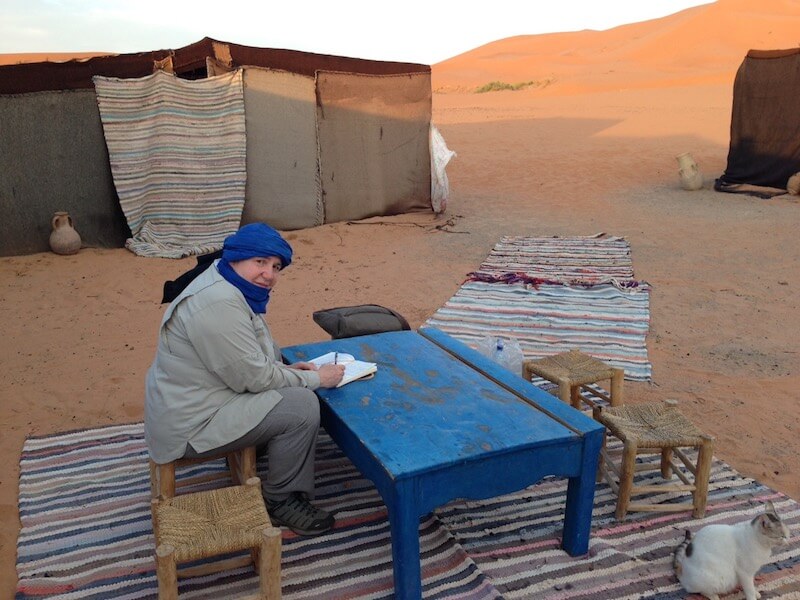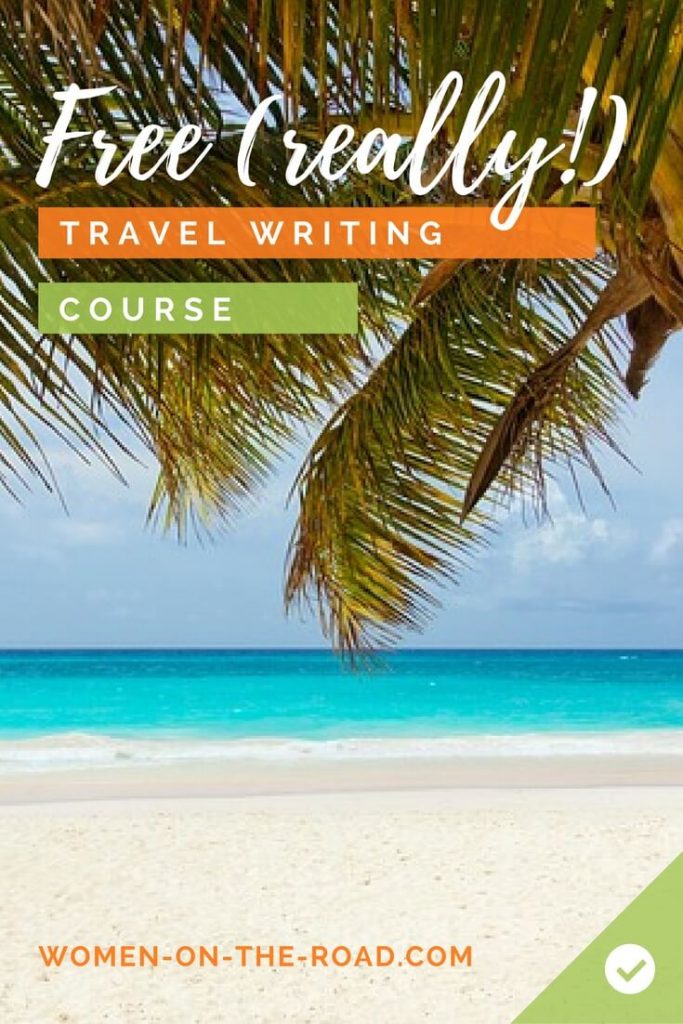If you love to travel and love to write, this free travel writing course will get you one step closer.
Get your favorite writing implements out, sit back and let me unwrap the magic of travel writing for you.
You don’t have to be a brilliant writer, nor do you need to know everything about putting a story together. You do need passion, a desire to succeed, decent technique and an understanding of what editors want.
I can’t give you the passion or the drive – but I can help you develop the technique and get into an editor’s mind.
Where should you start?
Right here.
A few years ago I wrote a six-part primer called The Travel Writing Magician to walk through some of the basics of becoming a money-earning travel writer. The course was distributed via email for years and eventually turned into an e-book. Now I’m making it available for free to all readers of Women on the Road. That’s you!
This course combines my own decades of news reporting with great travel writing practice. I’ve written more than 2000 articles in my life as a journalist, and I now apply these techniques to my travel writing.
I’ll show you how to…
- Find an ‘angle’ for your story
- Sell the same story over and over again and keep getting paid for it
- Make your story irresistible to editors
- Double your income by including photographs with your stories
- Submit killer query letters that will be hard to turn down
- Find the experts that will ‘make’ your story
- Get most of your legwork done before you even leave home
- Grab that headline
- And a lot more!
Let’s be clear, though – this is NOT a “how to write a travel story” course. If you want to learn how to write and structure a travel story, I can recommend two courses:
- Mike Sowden’s “Engage” storytelling course, because telling stories is at the heart of travel writing, and he is just great at it!
- Write Like a Honey Badger by travel writer Amanda Castleman, a skilled editor whose course I’ve taken and loved – but not for beginners, more for those who need to hone their craft.

WRITING TRAVEL ARTICLES THAT SELL
I worked my way across Africa by writing.
And Asia.
And the Caribbean.
I’ve worked from palm-fronded beaches, desert oases, icy mountaintops and tropical rainforests.
I swam with stingrays off the coast of Eritrea, got lost in the Amazon, fetched my own water and built my own cooking fire in the heart of Zimbabwe.
I have been privileged to see the world at my pace, combining my love of travel with my love of writing.
And you will too if you’re serious about writing stories that sell.
Now don’t get me wrong – it was a bit like roses: beautiful, but with plenty of thorns along the way. It’s not easy to make a living as a freelance writer, travel or otherwise: it takes hard work, a reasonable command of the English language and a helping hand from those who have done this before you.
So if you’ve always dreamed of travel writing and thought you couldn’t – think again. During these six lessons I’m going to share my hard-earned arsenal of tricks with you.
If you apply them and work (really hard) at learning your craft from the ground up, you’ll be getting closer to writing – and selling – your travel stories.
You’ll have the freedom to travel and see the world, in a way you never dreamed.
Are you ready for the first lesson on how to be a professional travel writer? (I’ve provided the first lesson here so you can see what the course is like. To get all six lessons, click the link below).

LESSON 1: ANGLING YOUR STORY
Getting the angle or the peg is one of the most important decisions you’ll ever make when you write a story.
Without an angle, you have no story. You know what you’re seeing and what you want to write about. Now you have to figure out how to slant it.
Let me explain.
“Paris.”
That’s a destination.
“Paris is a big city.”
That’s a description.
“Even though Paris isn’t the world’s biggest city, it looms large in the heart of romantics everywhere.”
Not a great sentence, but it tells the beginning of a story – it has an angle, an idea, a perspective, an approach.
Writing a travel story isn’t about delirious descriptions or lists of must-see sights.
Editors can find these on any website or guidebook. Your job is to provide a little extra, a twist that will make something old seem new, or something common seem exceptional.
Do you know how few travel writers actually realize this?
Many writers think a good description, well-written, with plenty of colorful adjectives makes a great travel story (I know this because I too have been guilty of this kind of writing). Most editors, on the other hand, are looking for something more.
One technique I use to find new story angles when I’m writing about a place is to insert a word right after my destination.
Let me show you how.
We’re writing about Paris, right? So why not try:
- Paris… romance
- Paris food
- Paris fashion
- Paris language
- Paris history
- Paris museums
- Paris flea markets
- Paris streets
- Paris fountains
- Paris chocolate
- Paris pastries
- Paris theater…
Each one of these could easily yield a dozen story ideas.
Another technique I use is to ask these questions:
- What’s new about this?
- What’s first about this?
- What’s biggest, smallest, oldest, youngest, best or worst about this?
- What’s special about this?
- What makes me the expert on this topic?
These are the things that will sell your writing.
Editors want to learn something from your piece: if they learn something, so will the reader. They want to feel excited and inspired by looking at a place through a different lens. You can provide that difference.
I hope this makes sense! In case it doesn’t yet, let me give you another example from my own experience.
On a trip to Thailand I didn’t write about my itinerary, nor did I provide a long list of tourist attractions. Here’s what I explored instead:
#1. Scrumptious Thai food – what it is, how to prepare it, how to shop for it, best restaurants, eating utensils, etiquette, unusual food specialties, the difference between Royal cuisine and common cuisine
#2. Relaxing beaches – where to bliss out, visiting The Beach film set, massages on the beach, best beaches, living cheaply on the beach, and the safety of beaches after the tsunami
#3. Shopping in Thailand – amazing Chattuchak Market, antique shops, tailored clothes at Thai prices, the history of Thai silk, Jim Thompson’s story, the ins and outs of bargaining
#4. Spiritual Thailand – best meditation retreats, reflexology on every street corner, Thai temples and what they mean
#5. Poverty – child beggars, refugees from Burma, deforestation in the North, trafficking of women and children (these aren’t technically travel stories, but I care about these issues so I wrote them – and sold them)
When you set out to write a travel story, remember – it’s not one story, it’s many. Imagine writing your own stories from each of these angles, and selling each to a different paper, magazine or site…
I pretty much did and I’ll show you how you can too.
So when you’re thinking of writing your travel story, ask yourself: can I find multiple angles?
If not, you’re shooting yourself in the foot. You’ll have fewers stories to write and to sell, so you’ll make less money. Imagine all that research about Paris just to sell one or two stories on the city as a destination. Not really worth it, is it?
I’ve given you plenty of ideas: now it’s time to come up with some of your own!
SELF-ASSIGNMENT #1: Practice finding angles
Choose a destination you can get to easily or that you know well – your own city, for example. Make a list of possible story angles. Don’t stop until you come up with at least 20. Then choose another destination and start again. And again. Once you’re confident about finding angles, challenge yourself: choose difficult destinations. The more ‘unexciting’ your choice, the harder you’ll have to work to find a great story angle. Remember, you’re laying important groundwork by doing this.
— Originally published on 11 January 2011
DO YOU LIKE THE COURSE SO FAR?
If you do, go right ahead and click below for my own secret strategies on selling story after story!





